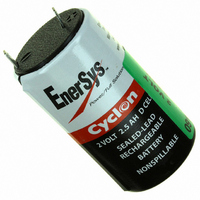0810-2044 EnerSys, 0810-2044 Datasheet - Page 11

0810-2044
Manufacturer Part Number
0810-2044
Description
BATT CYCLON SLA 2V 2.5AH GREEN
Manufacturer
EnerSys
Series
Cyclon®r
Specifications of 0810-2044
Voltage - Rated
2V
Capacity
2.5Ah
Size / Dimension
2.65" Dia x 1.35" H (67.31mm x 34.29mm)
Termination Style
Spade, .187" (4.7mm)
Rechargeability
Yes
Lead Free Status / RoHS Status
Lead free by exemption / RoHS compliant by exemption
Other names
842-1005
5.1 Introduction
Another area where the CYCLON
significant advantage over conventional sealed-lead batteries
is storage. This chapter devotes itself to offering the reader
useful information on properly exploiting the long storage
(shelf) life of CYCLON battery cells and monoblocs.
5.2 State of Charge
The state of charge (SOC) of the CYCLON battery cell can
be approximated by using the curve given in Figure 5-1. This
curve is accurate to within 20% of the true SOC of the cell
under consideration, if it has not been charged or discharged
within the past 24 hours. The curve is accurate to within 5%
if the cell has not seen any activity, charge or discharge, for
the past 5 days.
Figure 5-1: CYCLON
Vs. State of Charge
5.3 Storage
Most batteries lose their stored energy when allowed to
stand on open circuit due to the fact that the active materials
are in a thermodynamically unstable state. The rate of self-
discharge is dependent both on the chemistry of the system
as well as on the temperature at which the battery is stored.
All CYCLON batteries are capable of long storage without
damage. Figure 5-2 is a plot of maximum storage time as
a function of storage temperature. This curve shows the
maximum number of days at any given temperature, from
10°C (50°F) to 65°C (149°F), for the cell to discharge from
a fully charged state (about 2.14 volts per cell) down to zero
state of charge (1.93 volts per cell). The cell should not be
allowed to discharge below 1.93 volts because of the danger
of damaging the performance characteristics of the cell
permanently.
www.enersys.com
2.17
2.14
2.11
2.08
2.05
2.02
1.99
1.96
1.93
1.9
Chapter 5:
CYCLON
10
20
®
30
Battery Storage
®
Battery Open Circuit Voltage
40
State of Charge, %
50
®
battery product has a
60
70
80
90
100
Figure 5-2: CYCLON
Temperature
It is important to recognize that the self-discharge rate
of CYCLON batteries is non-linear. Thus, the rate of self-
discharge changes as the SOC of the cell changes. In other
words, the time taken for a cell to discharge from a 100%
SOC to 90% SOC is very different from the time it takes to
self-discharge from a 20% SOC to a 10% SOC.
6.1 Introduction
The superior charging characteristics of CYCLON batteries
makes them the power source of choice in demanding
applications that require rapid charging. Conventional
sealed-lead batteries are not suited for this type of charging
where charge currents can be of the order of 2C
6.2 General
Charging CYCLON sealed-lead acid products, like charging
other rechargeable batteries, is a matter of replacing the
energy depleted during the discharge. Because this process
is not 100% efficient, it is necessary to return more than
100% of the energy removed during the discharge.
The CYCLON battery cell uses the gas recombination
principle that allows up to 100% of the oxygen generated at
up to the C
water at the negative plate, eliminating oxygen outgassing.
Hydrogen gas generation has been substantially reduced
by the use of pure lead-tin grid material, which has high
hydrogen overvoltage. The corrosion of the positive current
collecting grid has been reduced by the use of pure lead-tin.
The amount of energy necessary for a complete recharge
depends upon how deeply the cell has been discharged, the
method of recharge, the recharge time and the temperature.
Typically, between 105% and 110% of the discharged
ampere-hours must be returned for a full recharge. Thus, for
every ampere-hour discharged, one must put back between
1.05 and 1.10 ampere-hours to ensure a full recharge.
3000
1000
100
10
Chapter 6:
Charging CYCLON
10
10
/3 overcharge rate to be recombined to form
20
Publication No: US-CYC-AM-007 - April 2008
®
Battery Storage Time Vs.
Storage temperature, °C
30
®
Batteries
40
50
10
60
or higher.
70
11















